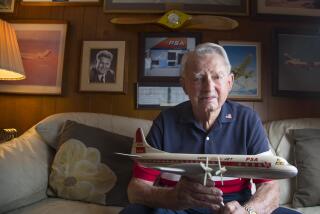Robert Gross Got Lockheed Off Ground
- Share via
In the late 1920s, the fledgling Lockheed Aircraft Co. was in horrible financial shape. Although its competitors Boeing and Douglas struggled mightily just to stay in the air, both companies had commercial aircraft that dominated the domestic market. Lockheed had none.
Things were so bad for Lockheed that by 1932, the Burbank-based company was bankrupt and in federal receivership. The company needed a savior and needed one right away.
Enter Robert Ellsworth Gross, a 35-year-old Harvard-educated businessman from Boston who, after investing in aircraft companies in Connecticut and Kansas, moved to California in 1930. Unlike other aviation pioneers such as Bill Boeing, Donald Douglas and John Northrop, Gross didn’t know how to fly or build airplanes. He had a knack, however, for turning troubled aircraft companies around to profitability.
Gross and his group of investors bought Lockheed from the federal government in June 1932 for $40,000. He eventually became the company’s board chairman, treasurer and president. The turnaround began immediately with the development in 1933 of the twin-engine Lockheed Electra. Soon, the Electra became a record-breaking plane of choice for Amelia Earhart and Charles Lindbergh, among others.
During World War II, Lockheed produced bombers as well as the P-38 Lightning, a twin-engine fighter that German airmen soon nicknamed the “twin-tailed devil” because of its unusual design and maneuverability.
After the war, Lockheed briefly carved its own commercial niche with the four-engined Constellation, built the first American fighter jet and established the “Skunk Works,” a top-secret aircraft factory that produced spy aircraft.
By the time Gross died in Santa Monica in September 1961, Lockheed was a multibillion-dollar corporation with huge defense contracts and worldwide subsidiaries.
More to Read
Inside the business of entertainment
The Wide Shot brings you news, analysis and insights on everything from streaming wars to production — and what it all means for the future.
You may occasionally receive promotional content from the Los Angeles Times.









